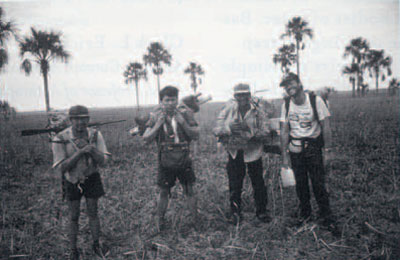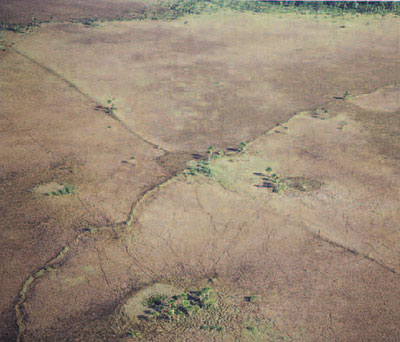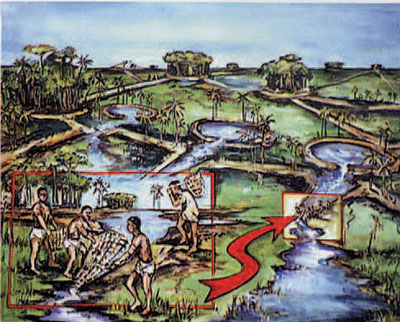
Popular images associated with the Amazon today include the towering continuous green forest canopy, Day-Glo poison dart frogs, and native faces painted red. These potent images have been used to raise funds for conservation, educate the public in “green” politics, and promote, ecotourism. Two themes have long dominated the popular and scientific literature on the Amazon: the Myth of the Pristine Environment, and the Myth of the Noble Savage.
The Myth of the Pristine Environment is the belief that the landscapes of the Americas were largely undisturbed until the arrival of Europeans, who have destroyed the environment with their agriculture, mining, urbanism, and industry. The Myth of the Noble Savage posits that indigenous peoples of the past and present exist as a harmonious part of an undisturbed Nature. We now know that much of what has been traditionally recognized as Wilderness in the Amazon is the indirect result of massive depopulation after the arrival of Europeans. The introduction of Old World diseases, slavery, missionization, resettlement, and warfare removed most of the native peoples from the land within 100 years. Many areas of Amazonia were not repopulated until this century and many still remain underpopulated.
My colleagues and I are documenting numerous cases of how native peoples of the Amazon (past and present) transformed, shaped, and in some cases, constructed what is often misidentified as pristine “wilderness.” Our approach, called historical ecology or the archaeology of landscapes, assumes that all landscapes have long complex histories. We find that high biodiversity is clearly related to past human activities such as opening up the forest, burning, and gardening. Since 1990, my research team has studied the vast networks of earthworks in the Bolivian Amazon built before the arrival of Europeans. These features include causeways of earth. artificial canals for canoe traffic, raised fields for growing crops in the savannas, and settlement mounds of urban scale.

In 1995, we were invited by the local governor to begin archaeological investigations in Baures, a remote region of seasonally flooded savannas, wetlands, and forest islands in northeast Bolivia. He loaned us his Cessna and pilot for an initial aerial survey of the region. As the plane circled the landscape. we saw an amazing web of straight roads, canals, and moated earthwork enclosures below. During the dry season of 1996, I surveyed the area accompanied by a group of local hunters (Fig. 1).
One artificial feature, referred to as a zigzag earthwork, particularly intrigued me. Low earthen walls zigzag across the savannas between forest islands (Fig. 2). Because of their changing orientations, they did not make sense as roads between settlements. As we mapped them with tape measure and compass, I noted that there were small funnel-like openings where the earthworks changed direction. I immediately realized that these matched the description of fish weirs that are reported in the ethnographic and historical literature on Amazonian peoples. Fish weirs are fences made of wood, brush, basketry, or stones with small openings that extend across bodies of water. Baskets or nets are placed in the openings to trap migrating fish. While most fish weirs are simple ephemeral structures crossing a river or shallow lake, those of Baures are permanent earthen features covering more than 500 square kilometers. In addition, small artificial ponds are associated with the weirs (Fig. 3). Today these ponds fill with fish as the floodwaters recede in the dry season. I believe that in the past these were used to store live fish until needed. Our studies show that the weirs were used before the arrival of Europeans to the region.

Drawing by Dan Brinkmeirer, Field Museum of Natural History, Chicago
The scale of the fish weir complex is larger than any previously reported. The native peoples of Baures shaped the environment into a productive landscape capable of providing sufficient protein to sustain large populations. The people responsible for this impressive land management are long gone or have forgotten the technology. Archaeology provides the only means of documenting this important lost knowledge. As politicians, conservationists, and aid agencies seek sustainable solutions to both develop and conserve the Amazon, archaeologists can play a key role by providing time-tested models of land use.
